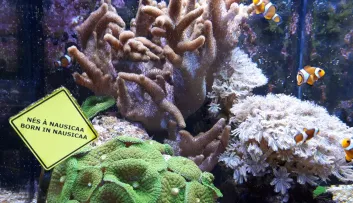Biodiversity Video 3mn
Atlantic Pygmy Devil Ray, a subject of conservation research
The collaboration between a researcher and the caretakers of Nausicaá to conserve the Atlantic Pygmy Devil Ray Mobula hypostoma.
Since 2018, Nausicaá's large tank of the high seas has been home to six Atlantic Pygmy Devil Ray Mobula hypostoma (four females and two males). This species, a cousin of the large manta ray, is still largely unknown and is currently classified as ‘Endangered’ (EN) on the IUCN red list.
To support the preservation of these rays in the wild and share the knowledge acquired by aquarists through daily observation of these fish, Nausicaá is supporting Atlantine Boggio-Pasqua, a doctoral student in marine ecology, in her thesis project on this high sea species.
Research in the field
Atlantine's fieldwork is taking place in Florida and the Gulf of Mexico. The aim is to gather information on the geographical distribution of these rays, their movements, their diet, as well as data on their size and weight.
To obtain this data, scientists capture individuals to weigh and measure them and take blood and muscle samples to establish their genetic map, before releasing them.
The Atlantic Pygmy Devil Rays are then tagged with acoustic or satellite tags to track their movements and determine population stocks. This knowledge is essential for implementing concerted conservation measures in the geographical areas crossed by these rays.
Sharing knowledge acquired ex-situ
Recaptures of marked rays are rare, making it difficult to monitor the growth and development of these fish.
This is where the data collected ex-situ, i.e. within the Nausicaá aquarium, becomes invaluable for researchers in the field. Nausicaá is the only European aquarium to have been exhibiting male and female Atlantic Pygmy Devil Rays since 2018. For six years now, the aquarium team has been gathering information on their growth (height and weight), diet and sexual maturity. The exchange of information is essential to a better understanding of this species.
On 25 September 2024, Atlantine came to Nausicaá to attend an ultrasound scan of a female Atlantic Pygmy Devil Ray. The caretakers had observed sexual courtship behaviour and biting on the females, suggesting that the individuals had reached sexual maturity, were fit to reproduce and had already been brought together. The female captured was not pregnant, but Atlantine was able to benefit from the advice of Nausicaáa's vet and observe his use of the ultrasound scanner, with a view to doing so herself during the next campaign in Florida.
Photo credit: Sean Thomas Photography
Conservation programme
Nausicaá's endowment fund has collected donations from visitors via the centre's events programme to finance beacons and an ultrasound scanner.
Nausicaá is taking part in the European conservation programme EEP - Eaza Ex-situ programme dedicated to the Atlantic Pygmy Devil Ray.

